One of our favourite memories from our trip to the Magdalen Islands in the winter was the photography. The islands practically capture themselves. There’s a remarkable vibrant and clear quality to the light in the winter and when paired with the landscape, magic is created in front of your eyes.
Thinking back on the planning of the trip though, it was not so obvious where we needed to be to capture these amazing photos. With a lack of information on winter, we relied on asking the local Madelinot. Now that we’re back, I can share with you the best winter photography locations in the Magdalen Islands along with all the details of the exact locations, timing, drone rules, and parking.
Read more about winter travel
- How to plan a 6 day Banff in winter itinerary
- Unique winter getaways in Ontario
- How to plan a Muskoka winter getaway
- Snowmobiling On The Trans-Quebec Trail 83
- Snow bath experience at Carnaval in Quebec City
- Ice canoeing in Quebec City
How to get the best travel deals
- Car rentals – stop getting ripped off and learn about rental car coupon codes.
- Hotels – Use corporate codes or get Genius 2 tier with Booking.
- Flights – Have you ever heard of the “Everywhere” feature?
- Deals – Bookmark our exclusive travel deals page for the latest offers.
In This Article
Favourite Magdalen Islands Winter Photography Locations
We’ve covered in depth all of the best things to do in the Magdalen Islands in the winter but one thing that didn’t cover were the exact locations that we travelled to in order to capture the incredible scenes that we witnessed on the islands.
This guide covers some of the best winter photography locations in the Magdalen Islands to help you plan your trip whether you love finding the most scenic spots or you’re a photographer, drone pilot, videographer or content creator.
BEFORE YOU CONTINUE
Learn about the Magdalen Islands in Quebec and all the things we did on our trip there in the winter time.
1. Dune du Sud
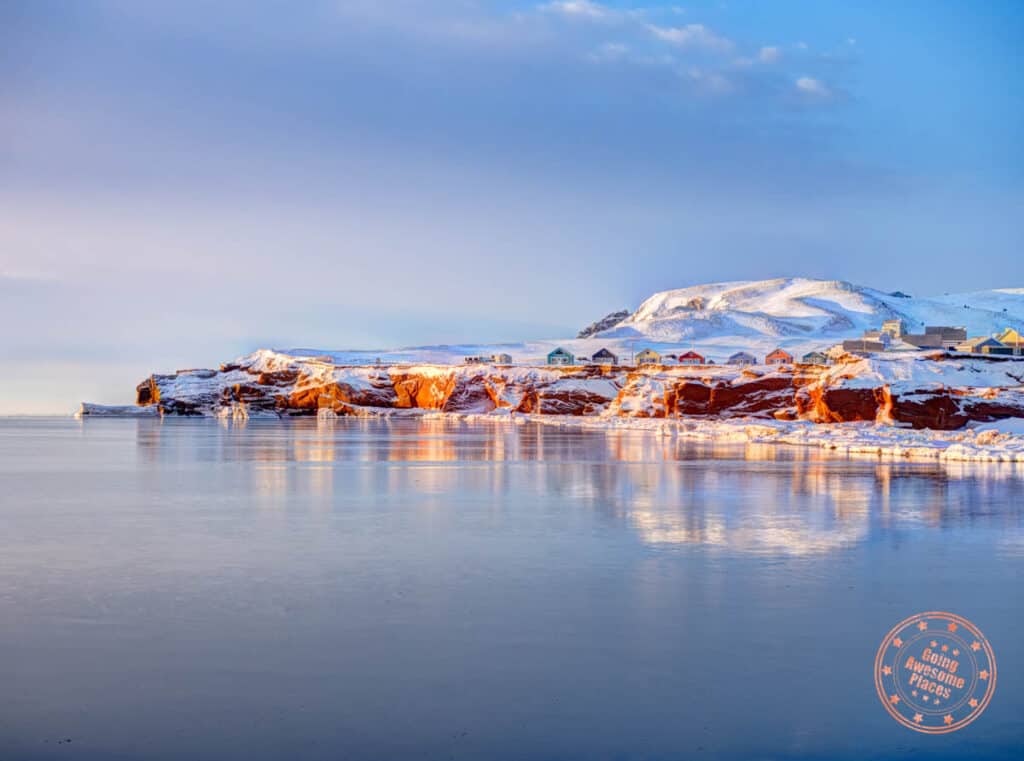
Right at the famed Dune du Sud beach in the Magdalen Islands is a magical view of colourful cottages and red cliffs on the flip side.
One thing you learn quickly about Îles de la Madeleine is that Google Maps isn’t a great resource for the best scenic points and you also can’t find the best photography spots online. One of the challenges is that some just don’t really have an official name like this one.

This postcard view starts right at the southern edge of Dune du Sud Beach. After parking in the area, look for a rocky outcropping (rock barrier) that juts out into the water. In the winter, this is normally covered by snow but it’s wide enough where it feels quite safe.
From this vantage point, you get a better view of the warm glow of sunrise reflecting on the water, jagged cliffs, crayon coloured cottages, and the hill behind.
I’d say flying the drone here is nice because you can capture different aerial angles but in reviewing our photos, I would say it’s optional as the photos from the ground are near-perfect.
The cottages are called Domaine des Vacanciers (Domain Holidaymakers) which will appear again later in this list.
WHAT YOU NEED TO KNOW
Address: Dune-du-Sud, Havre aux Maisons Island, Quebec G4T 5G1
Best time to go: Sunrise
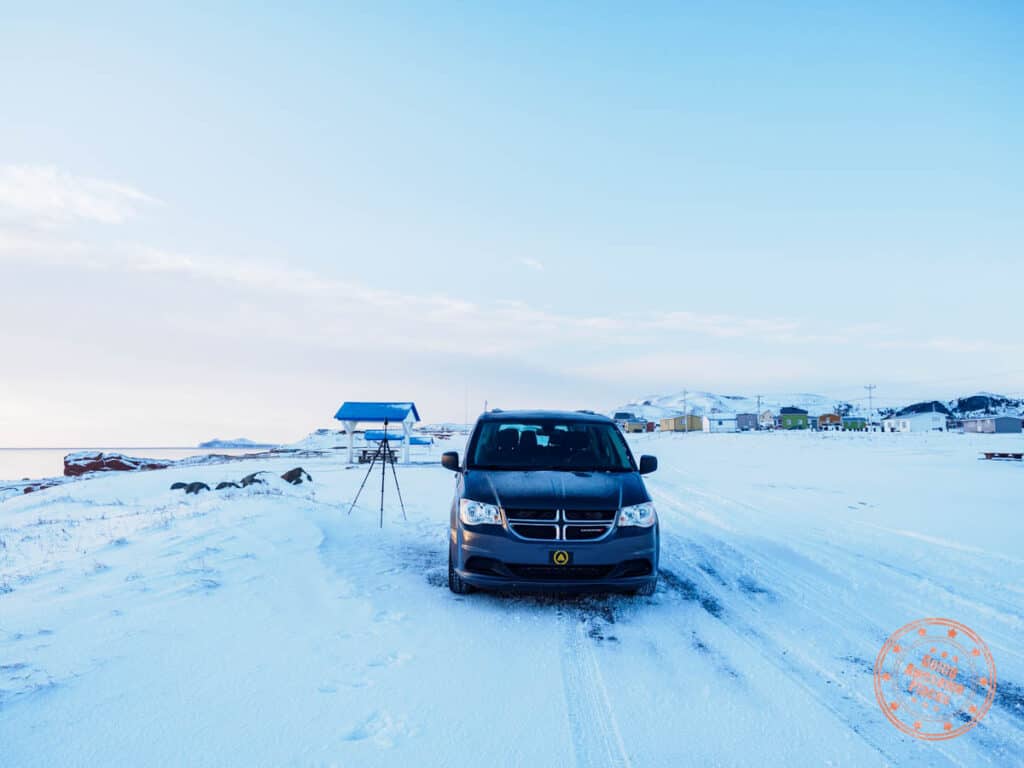
Parking: There is quite a large parking lot here for the beach including picnic benches. In the winter, plows do come through this area so you can park anywhere.
Drone rules: Dune-du-Sud is right next to the airport which means that you’ll need permission from NAV Canada to fly. Don’t miss our guide at the bottom to learn how this works. I would not recommend flying here otherwise because 1) it’s illegal and 2) you are right on the line towards one of the runways. This is in a zone that needs to be manually approved by the control tower (Class A).
Tips:
- Make sure you have good boots to walk on the snow-covered rocks.
- You don’t necessarily have to go all the way to the end of the rock barrier. Somewhere in the middle
- Be careful of the rocks near the water. The snow can be deceiving so make sure you’re planting your feet on solid rock.
- If you want to be extra safe, slip on a good pair of crampons.
- The sun rises in the direction of where the rock barrier is laid out so you won’t get the sun peeking out from behind the cottages but at golden hour, there’s a beautifully soft golden glow on the cliffs, snow, and houses that you definitely don’t want to miss.
2. Cap Alright Lighthouse

There’s a true maritime vibe to the Magdalen Islands and the anchors of that are definitely the lighthouses that are scattered all around. If you’ve read our top places in the islands in the winter, our second item on the list are the lighthouses.
One of our absolute favourites is the Cap Alright Lighthouse (aka Cape Alright Lighthouse). It’s small in stature but has a ton of heart. It was built in the 1800s to help ships from crashing but more recently, a famous Quebec host purchased this little lighthouse from the government in order to save it and restore it to its former glory.
Technically this is private property but the owners are quite friendly and most visitors do end up walking right up to the lighthouse.
The position of the the lighthouse is perfectly lined up with the sunrise in the background which makes this an awesome location to photograph. With the wide open space to work with, you have a lot of options in terms of how you want to frame your shot.

There is also an alternative view of the lighthouse if you walk downhill from the parking lot northwards. You’ll eventually reach a point where there are stairs down to the beach. From here, you’ll be able to capture a sideways view of the lighthouse with the red cliffs facing towards you.

Drone footage and photos from Cap Alright Lighthouse are quite stunning especially when you can frame the lighthouse and sunrise at a higher angle than you would be able to from the ground.
Also, since you can’t really see the red cliffs from the lighthouse, flying out towards the water and photographing back towards the island means that you can capture many jawdropping details including the formations in the ice, the small arch in the rock, the cliffs, small houses, and the La Butte Ronde hill to the right.
WHAT YOU NEED TO KNOW
Address: Pointe-Basse, Havre-aux-Maisons, Quebec G4T 5J6
Best time to go: Sunrise
Parking: There’s a parking off of the road (Chemin des Échoueries) that’s plowed in the winter. This is as far as the road will take you though. You cannot drive north from the lot because this is not maintained and not covered by car rental insurance.
Drone rules: Cap Alright Lighthouse is still in the no-fly zone since it’s near the airport is right next to the airport. Again, you’ll need permission from NAV Canada to fly. This is in a zone that needs to be manually approved by the control tower (Class A).
Tips:
- It’s not recommended to walk near the edge of the cliff or beyond the lighthouse where the land stretches out towards the water. In the winter, everywhere is covered with snow and ice so you don’t want to risk slipping off.
- To stay outside of the private property, you can photograph the lighthouse from the parking lot which is bound by a low wooden fence.
- Walking downhill towards the alternate view can be quite slippery because of the ice so be careful and use crampons as needed.
- If the snow is not too high, there are ways to get all the way down to the beach.
- There’s a limited window of time for sunrises so if you are able to request permission to fly a drone in this area, it’ll give you the most flexibility to be able to photograph multiple locations without having to trek through the snow.
3. Château Madelinot
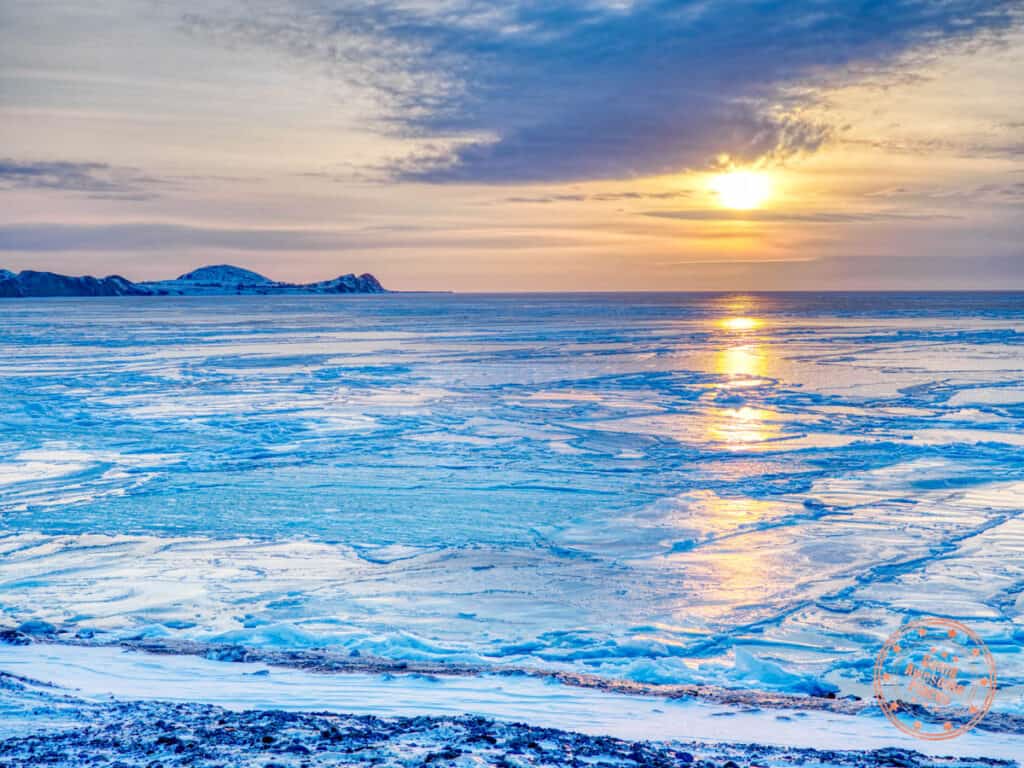
This is the hotel we stayed at and if you’re here as well, there’s a certain level of comfort in doing your sunrise photography from here since your room isn’t far away and there aren’t any dangerous cliffs to worry about.
Château Madelinot also faces east like the preceding spots on the list which makes it great for the early risers. The beauty of winter is that you end up with these mesmerizing scenes of the sun reflecting its glow off of the frozen ice while shimmering in the distance where it has thawed.
Walking out towards the water from the hotel gives you easy access to the pebble beach which is visible even under thick snow, ice formations at shore if it’s been cold enough, and the gazebo on the hill.

The beach features make excellent foreground subjects as does the adjacent yellow house.
From a drone perspective, you can get a nice wide aerial view of the hotel and Havre-aux-Maisons but I wouldn’t say it’s necessary since you can easily walk up to the gazebo and capture photos from a higher elevation from there.
On a clear day, you’ll also be able to see Entry Island (Île d’Entrée) in the distance.
The sunrises from here are just as vivid as other parts of the islands so we recommend that you try this earlier in your trip so you can get comfortable being out in the cold, and figuring out your timing.
WHAT YOU NEED TO KNOW
Address: 323 QC-199, Fatima, Cap aux Meules Island, Quebec G4T 2H6
Best time to go: Sunrise
Parking: There’s a large parking lot for the hotel.
Drone rules: Château Madelinot is still in the no-fly zone as it’s still close to the airport. Again, you’ll need permission from NAV Canada to fly. However, it is in the part of the zone that is automatically approved by the app. This is Class B airspace.
Tips:
- You’ll be tempted to get right up to the ice at shore but be careful to not mistake it for solid ground as you may accidentally cross into water. Try to stay near the pebble beach.
- The walk up to the gazebo while steep is pretty easy and clear to get up. It wasn’t icy when we were there so a good pair of boots should be fine.
- The gazebo can get windy depending on the day so make sure you’ve got the right clothing to stay warm.
- There may be ice underneath the heavy snow cover on the way to the beach so walk carefully.
WHAT TO PACK?
Packing for cold weather is a whole other ball game. To enjoy your winter in the Magdalen Islands, you need to make sure you have the right gear. You’ll want to read this before you go.
4. Borgot Lighthouse

Our second favourite lighthouse we visited was Borgot Lighthouse which sits on the western end of Cap aux Meules Island and is near Belle-Anse.
Unlike the other 2 main lighthouses on the islands, this lighthouse is up on a hill near the edge of the cliff. You’ll notice that the shape is quite unique and distinct with a round base and topped with a red cap on top.
To get here, you won’t be able to drive all the way to the lot adjacent to the lighthouse because the road isn’t plowed so park at the lot further below and hike up. It’s an easy walk because you’ll just be following the paved road.
One of the advantages of coming here in the winter is that the snow transforms the landscape daily. With the wind, it’ll always feel like you’re stepping on fresh snow. When you combine the rolling white tundra with clear skies, golden grass, and the lighthouse itself, you end up with fantastic captures.
While sunset is ideal but as you’ll see from the photo above, you also can’t go wrong during the day.

Lastly, if you turn your head to the right, you’ll see that the lighthouse has great sight lines towards Belle-Anse. There’s a safe viewing point here that’ll allow you to take photos of the cliffs.
WHAT YOU NEED TO KNOW
Address: L’Étang-du-Nord, Cap aux Meules Island, Quebec G4T 0J2
Best time to go: Sunset


Parking: There is a lower parking lot that is maintained so park here and walk up. It’s possible to drive up to the upper parking lot but it is uphill so unless you’re confident with your car, we would not recommend it.
Drone rules: You are clear to fly here but be careful of wind.
Tips:
- Before you walk towards the lighthouse from the final parking lot, take photos of the lighthouse with the snow undisturbed.
- Getting low to the snow and getting the blades of grass in your foreground is an awesome shot.
- The cliff edges here are steep and sudden which is why it’s not recommended to go beyond the fenced area of the lighthouse.
- The walk up to the lighthouse is pretty easy even with snow cover so crampons aren’t necessary. The exception would be if the road becomes icy.
- There is a lookout to the right of the lighthouse that gives you a great view of the red cliffs towards Belle-Anse.
- You might be wondering why Belle-Anse isn’t on this list. The reason is because it’s technically not allowed to go beyond the parking lot because of the heightened danger of erosion so it is not recommended in the winter. The trail there opens up in the spring.
5. Grande Entrée Wharf

Fishing is the lifeblood of the Magdalen Islands and in the summer there are boats constantly coming in and out of the islands. In the winter though, Madelinots finally get a break and so do those fishing vessels.
Grande Entrée island is the lobster capital of Québec and as a result, Grande Entrée Wharf is the largest fishing port on the islands.
When you visit in the winter, you’ll find a large fleet of boats on storage near the wharf, propped up above the ground. While not necessarily a traditional tourist attraction, anyone can come here and walk amongst these boats, see how each is built and decorated differently.
As a photographer, this is your chance to capture interesting angles of boats in one yard.

If you fly a drone, you’ll also be able to experiment with how to capture these boats.
While Grande Entrée is the largest wharf, you can also visit any of the others on Îles de la Madeleine including the one by Anse de l’Étang du Nord, and the main port in Cap-aux-Meules, to name a few.
WHAT YOU NEED TO KNOW
Address: Grande Entrée Island, Quebec G4T 9C4
Best time to go: Anytime
Parking: The wharf isn’t gated so you can drive right in.
Drone rules: You are clear to fly here but be careful of wind.
Tips:
- The area can be quite icy so be careful walking around.
6. Old Harry Beach

When you’re planning your trip to Grande Entrée island which is quite a far drive if you’re staying at Château Madelinot, you should definitely add Old Harry Beach (Grande Échouerie Beach)to your itinerary.
From the outside looking in and reading mostly summer content, it’ll look like just another one of the incredible beaches on the islands. However, there isn’t much information around what it looks like in the winter.
So yes, Old Harry beach has an impressive 14 miles of uninterrupted sand dune but in the winter it’s just a sweeping tundra of snow. You’ll find locals walking their dog there and as a photography, you won’t find it too interesting.
Where it gets interesting is the peninsula that doesn’t get mentioned in any of the guides. There’s a road that takes you all the way to the end and it’s here that you have quite the dramatic combination of red rock cliffs that strike out into the water and also a small bay that keeps its own collection of ice floes.
WHAT YOU NEED TO KNOW
Address: Chem. Head, Grosse-Île, Quebec G4T 6B5
Best time to go: Sunrise but it might be difficult to plan because of how far it is.
Parking: The road, Chemin Head, is plowed so you can drive all the way to the end point.
Drone rules: You are allowed to fly your drone here.
Tips:
- Be careful of the cliff edges.
- The best views are from the drone.
7. La Petite Baie
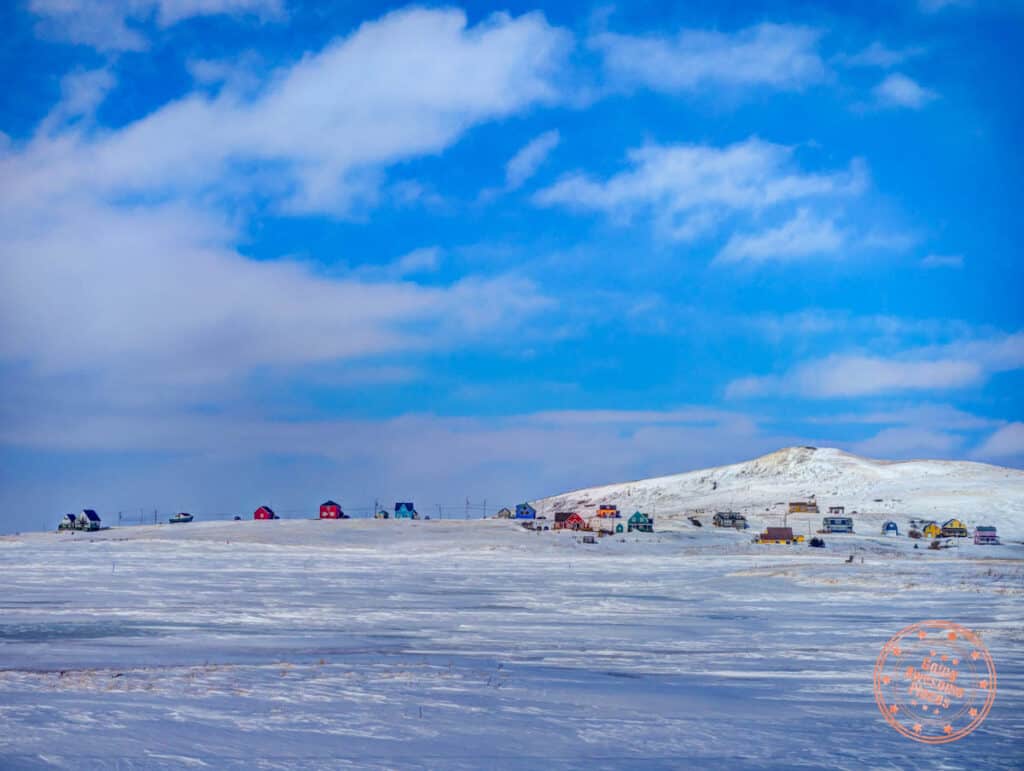
One of the iconic photography locations in the Magdalen Islands is this one of the colourful houses sprinkled on a vertical line.
In the summer, this is a gorgeous view with the bay of water in the foreground and row of houses propped in front of the rolling green hills.
I’d argue that it looks even better in the winter. With La Petite Baie frozen over, you have a clean white canvas that leads up to the houses contrasted by the blue skies.
The question though is where can you park and walk to in order to get a good angle of the houses. You’ll spot this from a mile away as you drive along Highway 199 but since there are no easy pull offs on the side of the road, your best bet is to park at Auberge de la Petite Bae, a summer B&B, or there’s the Plomberie Enterprise Lomer Richard, a plumbing store.
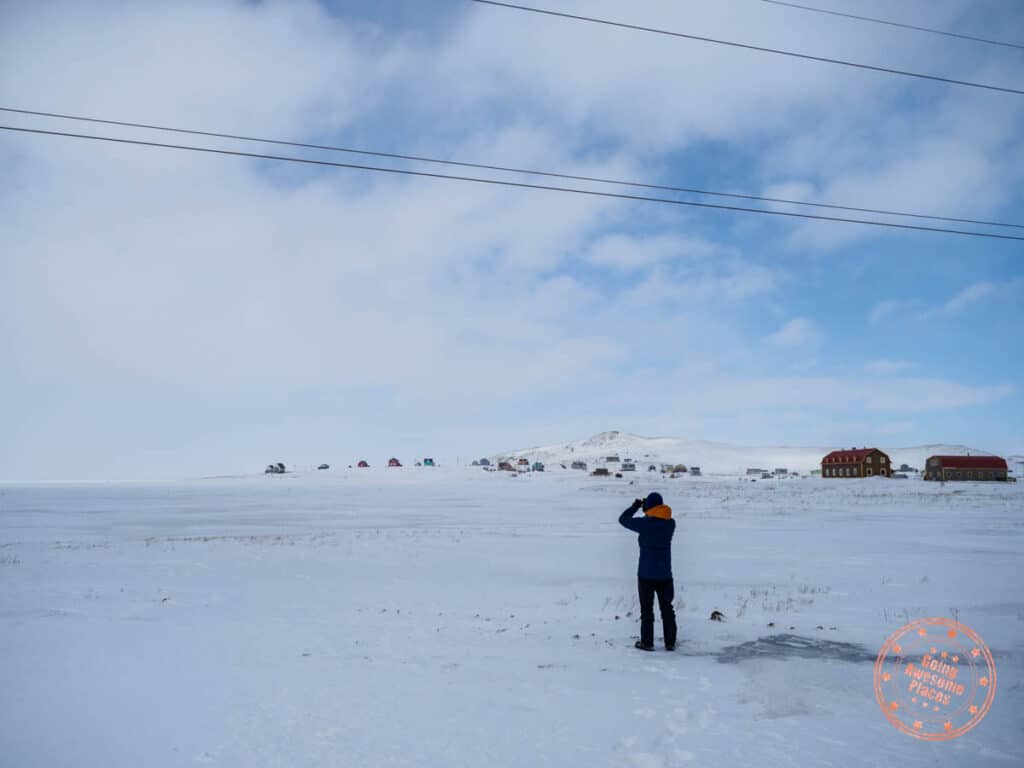
Once parked, you’ll be able to walk towards the edge of the bay and snap all the photos you want. Just be careful not to walk onto the ice as it’s hard to tell how frozen it is.
WHAT YOU NEED TO KNOW
Address: Auberge de la Petite Baie (187 QC-199, Havre aux Maisons Island, Quebec G4T 5A1) or Plomberie Enterprise Lomer Richard (221, 199 Rte, Hâvre-Aux-Maisons, Quebec G4T 5A1)
Best time to go: Sunset
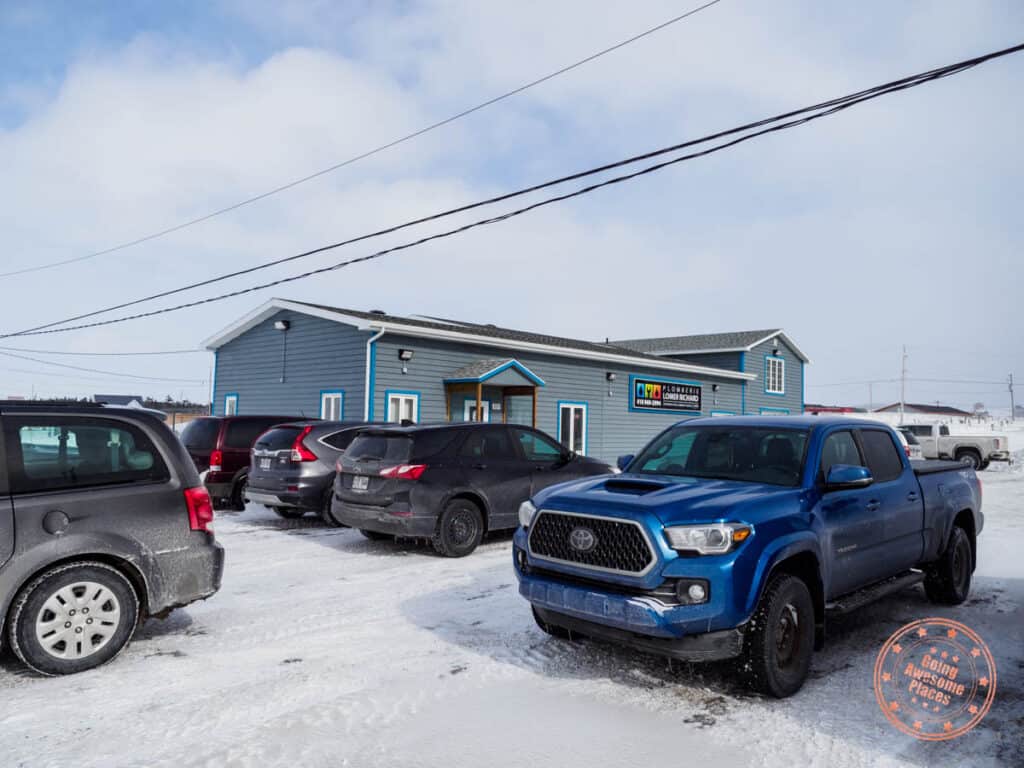
Parking: There is limited parking at Auberge de la Petite Bae but since it isn’t open in the winter, the lot may not be accessible because of the high snow banks created from the plowing of Highway 199. The easier lot to park is the Plomberie Enterprise Lomer Richard which has the benefit of being less conspicuous as well.
Drone rules: La Petite Baie is in controlled airspace since it is close to the airport so you would need NAV Canada permission which requires manual approval (Class A).
Tips:
- For the best photos, try to clear the power lines that run through.
- Be aware of the shoreline.
8. Colourful Houses

As you drive around the islands, you’ll discover colourful houses all over but most of them aren’t really marked on a map so here are the ones that we learned about.
Domaine des Vacanciers – This are the cottages featured from the first Dune du Sud photography location. These are available to rent even in the winter so if you’re coming here for photography, try to be discreet.
Les Chalets et Maisonettes La Martinique – This is the other set of colourful cottages in the Magdalen Islands right off of Highway 199. You can spot the difference with Domaine des Vacanciers because these don’t have the octagonal window at the top. They are also open in the winter.

Triangular Houses – These were much harder to find but they can be found in a few places on the island. We didn’t capture the addresses for them but keep your eyes peeled. Heads up that these are all private properties though.
WHAT YOU NEED TO KNOW
Domaine des Vanciers
Address: 290 Chem. de la Dune du S, Havre-aux-Maisons, QC G4T 5G3
Best time to go: Sunrise or early morning
Parking: There isn’t an official parking lot but if you’re quick you can make a stop near the cottages for a photo.
Drone rules: This is the same area as Dune du Sud so you will need permission from NAV Canada to fly your drone (Class A).
Tips:
- Try to be quick and discreet here as the owners of the cottage can see cars coming in and out.
Les Chalets et Maisonettes La Martinique
Address: 552 Chem. de la Martinique, L’Étang-du-Nord, QC G4T 3S5
Best time to go: Any time of day
Parking: Similar to the other cottage, you can make a quick stop.
Drone rules: You can fly drones in this area.
Tips:
- This is an active cottage so again, be discreet.
9. Dunes of Le-Petit-Havre

This is a part of the Magdalen Islands that was recommended to us by many locals that we encountered when we asked about where we could potentially spot harp seals on ice floes close to shore. We’ve also heard that this is a spot to see red foxes but we saw neither.
Like many spots on the islands that are popular beach spots, this transforms into a mysterious and wonderful photography location especially as the setting sun shines a light down the coastline.
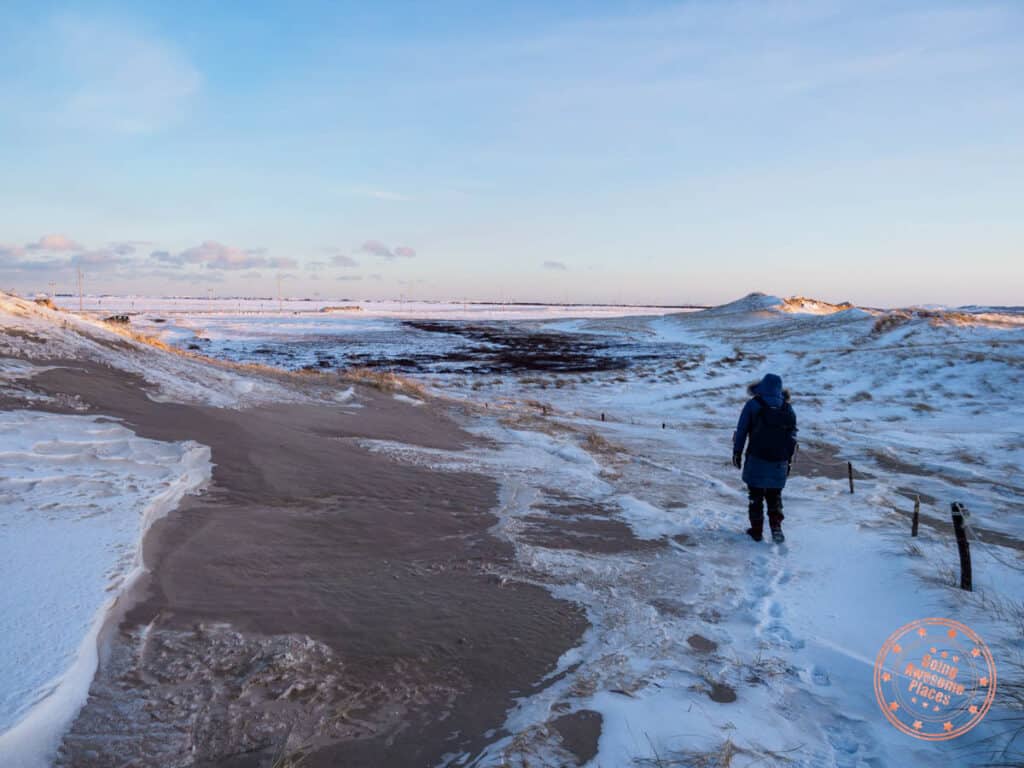
Come to Le-Petite-Havre to explore the land and go as far south as you’re comfortable.
WHAT YOU NEED TO KNOW
Address: This is the parking lot after you cross from Havre-aux-Maisons towards Pointe-aux-Loups on Highway 199.
Best time to go: Sunset

Parking: In the winter, it’s easy to miss the parking lot for the beach but it should be good enough to enter by car.
Drone rules: This area is under controlled airspace so you will need to submit a flight plan for approval (Class B).
Tips:
- There is a pretty clear path through the dunes that is semi-marked. Just follow the natural snow path up. It should not be icy but pack a pair of crampons in case.
- When you’re at the top of the dune, be careful of the steep drop and find a gradual way down to the beach.
- It is quite windy at the top of the dunes so make sure you’re dressed appropriately.
10. Red Foxes
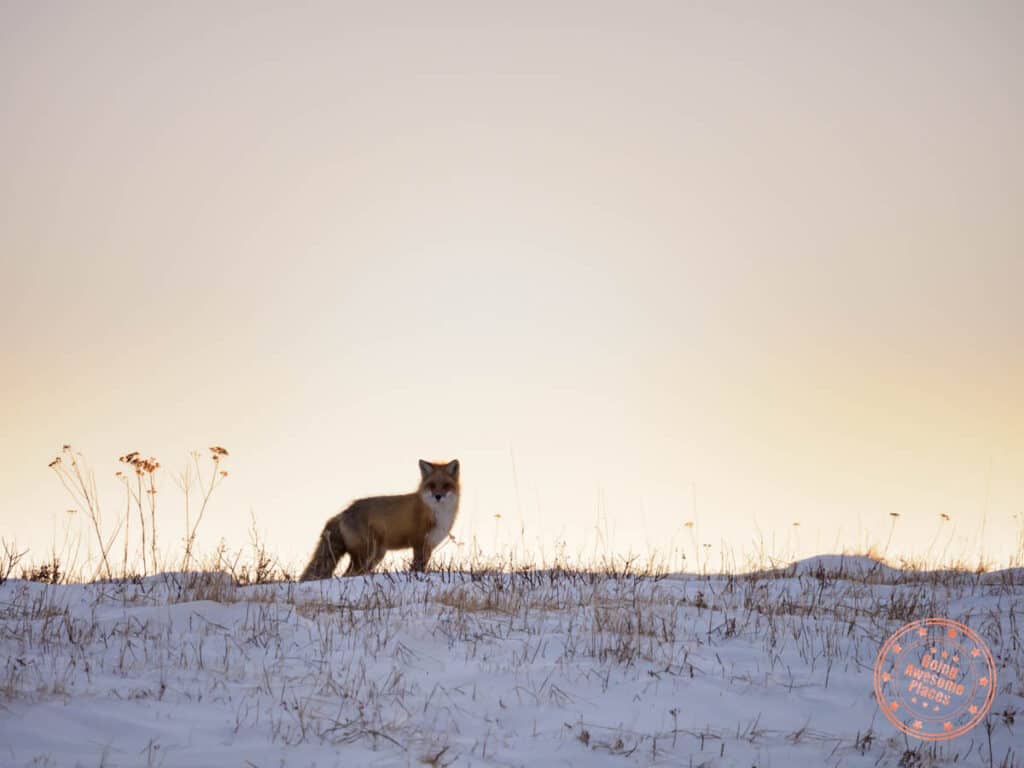
Red foxes are indigenous to the islands and are a great subject to photograph in the winter. With their furry red coat, white tail, and pointy ears, they stay hidden during the day but come out at sunrise and sunset to hunt for food.
Now I wish I could tell you exactly where to go because they don’t stay in the same den but what I can do is share with you our experiences of where we photographed the one above.
We didn’t think we would be able to photograph them but while we were visiting Fromagerie du Pied-de-Vent, one of the employees there told us that she’s seen a fox hang out by the road on her drive home from work.
At first, I didn’t think we’d seriously attempt it but since I knew that foxes also go hunting in the morning, I dropped by after my sunrise shoot at Cap Alright Lighthouse. Slowly driving on the road, I looked to my left and to my surprise, there the fox was, roaming on the hill. I was totally not ready and since I didn’t pack my super telephoto lens, I was only able to snap a few shots before the fox disappeared.
That same afternoon, we were trying to figure out where to go for sunset and last-minute decided to detour back to the fromagerie area again to test our luck. We parked on the side of the road and equipped myself with the Olympus 100-400mm lens and waited patiently. The red fox wasn’t there right away but with a bit of patience, it appeared!
Thankfully we had our gear from The Heat Company (Durable Liner Pro + Full Leather Pro) which allowed us to photograph and take videos of our fox as he/she hunted for mice underneath the snow. It was utterly fascinating to watch the fox sit still and tilt its ears to listen for noise underneath before jumping 5 feet in the air to pounce.
Good luck!

WHAT YOU NEED TO KNOW
Address: On Chemin de la Pointe Basse between Highway 199 and Fromagerie du Pied-de-Vent
Best time to go: Sunrise (6-8AM) or sunset (5-7PM)
Parking: You may have to find a safe space to pull over on the road. Be mindful of the surrounding road traffic. It may be safer to park on a side street or lot nearby and walk to the location.
Drone rules: This depends on where the foxes are.
Tips:
- While the fox isn’t shy and will get up decently close, you’ll still need a super-zoom to get a close-up photo of the fox. As a micro four-third user, I currently shoot with the OM-D E-M1 Mark 3 and the 100-400mm/f 5-6.5 was just the right amount of reach. I tested the 2x teleconverter but it wasn’t woth the 2 stops loss of light at sunset.
- Don’t be shy. Ask locals whether they have seen any foxes or know someone that might have.
- Since we had luck at Fromagerie du Pied-de-Vent, I might start there.
- Another person that was really knowledgeable about foxes was Cindy at her cafe, Cindy Hook Café.
- Expect to be outside for an hour or two so wear the right cold weather gear.
The Heat Company Promo Code
There’s a hidden 10 pack hand warmer page on The Heat Company’s Canadian page and if you use code GOINGAWESOMEHEAT, those hardwarmers are free for every single purchase.
11. Anse-à-la-Cabane Lighthouse

Since we covered 11 of our favourite things to do in the Magdalen Islands in the winter, it’s only fitting to end this list off with an eleventh item.
Anse-à-la-Cabane is the tallest and oldest lighthouse that is still in service on the islands. It’s located on the southern island of Havre-Aubert and makes a perfect combination with Atelier Côtier and La Grave historic site.
You’ll find this lighthouse to have a unique hexagonal structure set amongst frozen hay bales, and a historic light keeper’s house and other outbuildings.
From a winter photography perspective, like everywhere else on this list, you’ll have the space all to yourself so feel free to get right up close or shoot from further away.
If you’re licensed, you’ll be able to fly your drone freely as well and we recommend that you pull a bit further back to capture the entire landscape of the island.
WHAT YOU NEED TO KNOW
Address: Chem. du Phare, Bassin, Havre Aubert Island, Quebec G4T 0J2
Best time to go: Sunrise or sunset since you’ll get light shining either to the left or right of the lighthouse.

Parking: There’s a road that takes you down and past the lighthouse. At the end of this road is an open area that might not look like parking but is a lot.
Drone rules: You are allowed to fly drones here.
Tips:
- As with everywhere else on the island, be careful of the cliff ledges.
Photography Tips in the Magdalen Islands in the Winter
Whether you’re a first timer or a pro, here are a couple of reminders for what to expect and look out for when it comes to winter photography in the Magdalen Islands.
- It’s cold – Whether it’s a sunny day or a blizzard outside your window, be prepared with your full winter set up. Our handy cold weather packing list delves into everything we brought but your first priority is to have the right clothing.
- Winter photography gloves – Handling a camera or drone, you’ll want dexterity in your fingers so I highly recommend The Heat Company’s system (review coming soon) where you have liner gloves that have hand warmer pockets and a convertible shell on top so you can quickly switch to mitten mode.
- Organize your gear – Make sure you have a good bag and system in place so you can minimize the switching of gear and if you need to, making sure you know where everything is and is easily accessible. The ideal scenario is that you never need to take off your gloves outside.
- Rental car advantages – Take advantage of the space you’ll have in the rental car. You’ll find it helpful to lay out your gear so you can pick and choose what you need when you’re at a new photography location. For instance, you don’t always need to have a tripod with you so leave that in the car.
- Battery life – Cold weather will cut battery life significantly so be prepared to carry a lot of batteries with you, be able to charge in the car, and have a multi-battery charging system in the hotel.
- No Streetsview – It’s usually helpful to check out Google Streetsview to do some location scouting but you’ll learn that the islands haven’t been mapped so hopefully the guide above will help you plan your itinerary.
- Know your drone rules – If you want to fly legitimately, make sure you read the section below for how to do it properly.
- You won’t last outdoors as long as you think – Despite all of the cold weather gear planning you’ll be doing and being bundled up to the max, it just won’t be the same as shooting in warm weather. Everything is just a bit more complicated in the cold, you’ll get tired faster, and the cold will eventually catch up. From personal experience, I had to work faster and be okay with “Oh, that’s good enough”.
- Sunrises are the best – Between sunrises and sunsets, you’ll enjoy sunrises more because the weather is much calmer, the colours incredibly vivid, and you can plan time around it better (sacrificing some sleep of course). We found with sunset, we were always rushing to it and many times, not making it because we were coming from somewhere else.
- Be early for sunrises – From some trial and error, we learned to arrive one hour before the listed sunrise times to give yourself enough time to set up and also catch those deep dark blues, magentas, and reds as blue hour leads to golden hour.
WHAT CAMERA GEAR TO BRING?
Curious the kind of gear we use for photography, videography, and drone work? Don’t miss our article where we go into everything in-depth.
How to Fly A Drone in the Magdalen Islands

With this being a relatively new form of photography and videography, we could barely find any information about this online in terms of rules and
Minimum requirements for flying a drone in the Magdalen Islands and the rest of Canada for that matter:
- Basic drone license – At a minimum get a Basic Operations drone pilot certificate. This will allow you to fly in areas that aren’t restricted (uncontrolled airspace).
- Advanced drone license – If you plan on flying in any of the controlled airspace (near the airport), you will need an Advanced Operations drone pilot certificate. With this certificate, you can fly in Class A to E.
- Register your drone – Whether you’re from Canada or not, make sure your drone is registered and marked. It only costs $5 CAD.
- Sign up for NAV Canada – If you have any plans to fly in controlled airspace with your Advanced Operations certificate, make sure you create an account with NAV Canada and go through drone flight authorization.





The good news is that NAV Canada now makes it quite easy to put in your flight plans and request authorization to fly in controlled airspace. Only those with an advanced operations pilot certificate will be able to make use of this.
After you’ve created a new account, make sure you’ve added your drone under “Gear” and you’ve uploaded your pilot certificate to your profile.
There is a desktop and mobile app for NAV Canada but we recommend that you do your planning on a computer.
Here’s what you need to do when creating a new flight operation.
- Draw area – You can draw a circle, zone, flight path and drop specific points. You most likely won’t know your exact flight path so we recommend that you just draw a circle around your point of interest. You’ll know whether you’re in controlled airspace because you’ll see the orange circles on the map.
- Add parameters – Here’s where you’ll need to give it a name, description, indicate the start and end time, and height (keep in mind 400ft AGL is the max). The timing matters but give yourself a good buffer to work with. Also, note that it’ll default to your time zone wherever you are at the time so adjust for time differences.
- Submit for review – Under “tasks” for the operation, you’ll then be able to submit your permission request.
- Review process – With the advanced license, you’ll be automatically approved if it’s Class A (Controlled high-level airspace) or the larger orange circle on the map. If it’s Class B (Controlled low-level airspace), this will need to be manually approved by the Îles de la Madeleine airport control tower. They usually approve by the next day from our experience.
- Check approval – You’ll receive an e-mail once automatically or manually approved. NAV Canada will also show that your flight operation is approved.
TIP: If you own a Mavic 3, NAV Canada doesn’t have the model as an option under DJI so just manually type it in.
Make sure to read this handy resource to figure out Canada’s airspace.
Lastly, I recommend you do your flight planning at least 2 days out from when you want to fly. The good news is that you don’t need to do it that far in advance.
Executing your flight in controlled airspace
When you’re ready to fly, we learned the hard way that you simply can’t start flying so make sure you read the below.
Class A Airspace – Manually Approved
If you’re flying at Cap Alright Lighthouse, Dune du Sud, or La Petite Baie, you’re in Class A airspace which means that the control tower will have this on file and will be monitoring your flight.
Something that’s quite easy to miss in their approval e-mail is that you need to call the control tower before you start your flight and again when you complete your flight.
Also, if you decide to not do your flight, you also need to let them know by calling them.
We didn’t realize this and received a call from the control tower after my morning flying around Dune du Sud.
Technically, you should be going to the NAV Canada app to “start” the flight plan and “end” it when complete but I never ended up doing this.
Class B Airspace – Automatically Approved
Things are much more relaxed for the wider radius circle in the controlled airspace. This includes flying around Chateau Madelinot and the dunes by Le-Petit-Havre.
In this airspace, you won’t need to call the control tower so once you’ve arrived for your flight operation, you can start and end on your own.
Map of Photography Locations in the Magdalen Islands
Taking the map that we created for the top things to do, this map features the parking spots and photography locations in the Magdalen Islands in the winter.
Frequently Asked Questions
Yes, as long as you have your basic or advanced operations pilot certificate, you can fly in the Magdalen Islands. Just be aware of which areas are controlled airspace. If so, you will need to submit a flight plan with NAV Canada.
In the winter, you are not allowed to walk on the trail that’ll take you to Belle-Anse due to safety.
The sunrise time shifts quite a bit throughout the winter but in February, it ranges from 7:33AM to 6:49AM.
Sunset times will vary throughout the winter but in February, it ranges from 5:09PM to 5:51PM.
What you should read next

Leave a Reply